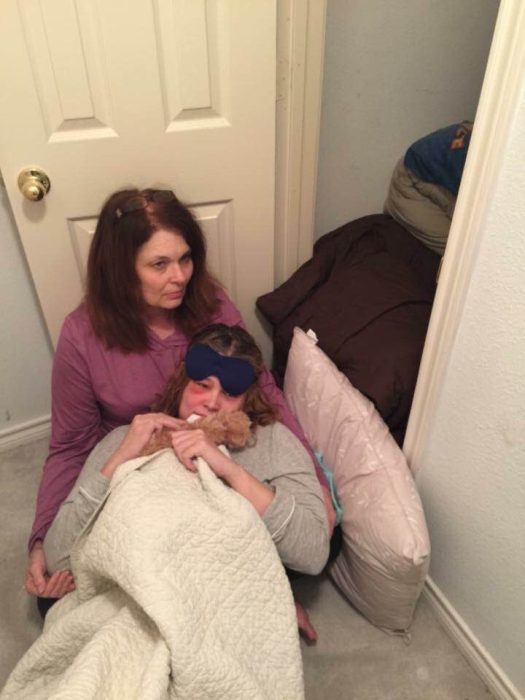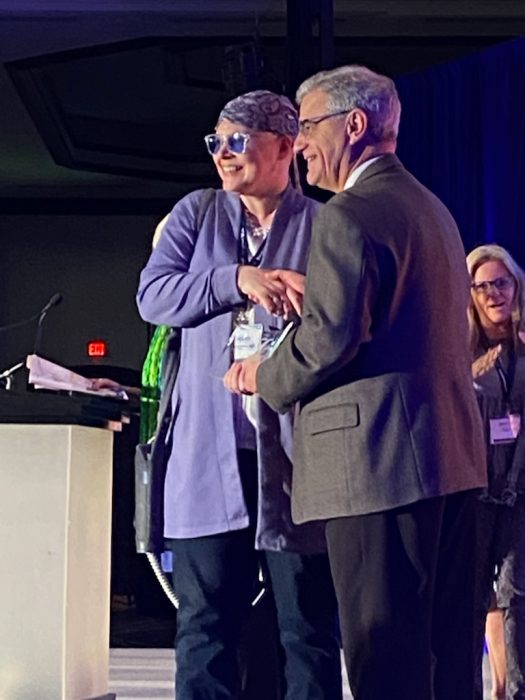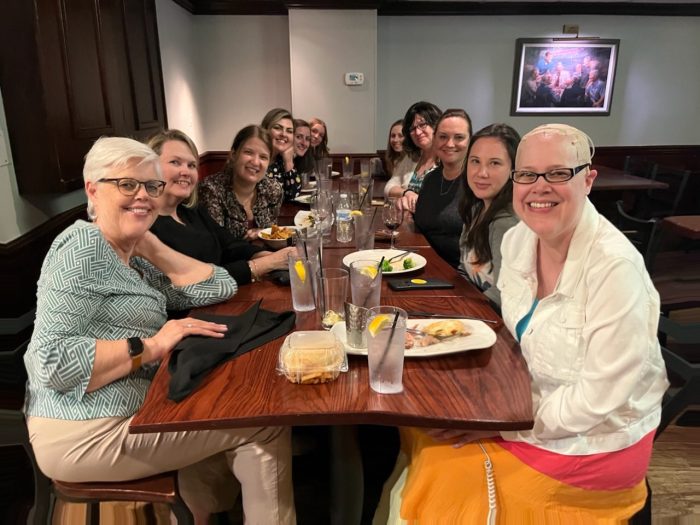On December 17, pro-life activist Jeanneane Maxon celebrated seven years of life post-cancer diagnosis — a diagnosis that doctors had determined to be “terminal.”
In 2015, Maxon was diagnosed with grade 4 glioblastoma (GBM), a fast-growing, aggressive, highly malignant brain tumor. According to her internet search, she had less than two years to live. Yet today, seven years later, following radiation, chemo, and an innovative new treatment called Optune, her scans are clear.
“I completely blew out everyone’s expectations,” she told Live Action News. “Even with the Optune treatment, after five years only about five percent of people with my diagnosis still are alive. And now I’m at seven years. There are people who survive that long with it but it’s really rare to find. They told me, ‘We’re never going to tell you you’re in remission because there’s not a cure for it.’ That was hard to hear. They’re not going to tell me I’m in remission. At the same time, I’ve had clear scans for at least six years– what they call no evidence of the disease, which means they can’t see any tumor progression. I think it looks really good, my prognosis. I think God’s healed me. My doctors think it’s a combination of all the different treatments I was on. But, it’s really amazing that I’m still here. I’m really grateful to still be here.”

Jeanneane Maxon is held by her mother Jenny following a tornado warning days after her brain surgery. Photo courtesy of Jeanneane Maxon. Do not reprint.
Leading up to her diagnosis, Maxon had been working with Americans United for Life (AUL) in Washington D.C. when she began having frequent headaches. However, since she had been suffering from migraines since she was six years old, doctors didn’t consider doing an MRI. They told her she was dehydrated and overworked and that she needed to rest. Maxon, therefore, made plans to leave her position with AUL and move to Texas to be near her family and get her health under control.
But, she explained, as she made these plans she had no idea there was a cancerous tumor rapidly growing in her brain.
Three months went by and she was packed and ready to go. Her father was in from Texas to drive the U-Haul with her belongings halfway across the country, and a friend would join her on the trip the Dallas. She had one more doctor’s appointment to get to before she left.
“It’s amazing when you think about how God does this. I had no idea there was a tumor in my head. Nobody wants this to happen, but if this is going to happen it could not have happened more perfectly than the way it was orchestrated,” she said. “Long story short, I had a seizure. I was doing quite a bit of traveling for AUL and I could have had a seizure on an airplane. I could have it driving in some location where I was away from my colleagues and my family or I could have even had it walking down the streets of DC in my high heels. Any of those situations would have been disastrous. […] I had a final doctor appointment with my endocrinologist for thyroid issues. That was on Thursday the 17th and so when I got to the doctor’s office inside the hospital complex, as soon as I handed the keys to the valet, I had my seizure. So instead of going to my doctor’s appointment, I was able to go into the ER, and long story short, eventually my dad and my friend joined me in the ER and they discovered I had a mass in the right frontal lobe of my brain. At that time they didn’t want to diagnose it as a tumor until a neurosurgeon looked at it.”
An MRI helped the neurosurgeon confirm that it was a tumor. Maxon was admitted to the hospital, her mother flew in from West Virginia, and the neurosurgeon, knowing that Maxon was in the middle of moving, released her from the hospital to go to Texas where she would meet with a different neurosurgeon on December 21. Once she arrived in Dallas, she was admitted to the hospital there. Two days later on December 23, she underwent surgery, and by evening on Christmas day, she was able to be home with her family.
“It took about two weeks for the biopsy to come back because it was Christmas and the New Year,” she explained. “Even though they had told me before the surgery, ‘We think this is going to be a grade 4 glioblastoma’ and then after the surgery when they actually saw what the tumor looked like, they informed me of that again. So we pretty much knew what the diagnosis was going to be but we had to wait until the New Year to get the official word that that’s what it was.”
The neurosurgeon didn’t give Maxon a life expectancy when she got the official diagnosis, but through research, she and her family learned that in most cases, people with GBM live about 15 months. At that point in time, many Americans had heard of GBM because of cases that had made national headlines. Sen. Ted Kennedy had died from GBM in 2009, and it was just over one year earlier, in 2014, that a 29-year-old woman named Brittany Maynard announced that she had grade 4 glioblastoma, and that she would be moving to Oregon to undergo physician-assisted suicide. For Maxon, that was never an option.
“The difference between me and her is obviously I’m not going to take my life even with a physician assisting. I’m careful not to speak for her,” said Maxon. “I don’t know exactly what her situation was. I don’t want to judge her decision because I’m sure that she was completely devastated — and I was too. But I was like — I’m going to do anything possible to try to stay alive.”

Jeanneane Maxon receives one of four Servant Leader of Year awards at the Heartbeat International Conference. Photo courtesy of Jeanneane Maxon. Do not reprint.
She notes that she also has a very supportive family who tried everything to help save her. She said that if she had told her parents that she wanted to access physician-assisted suicide in order to avoid the suffering she would have to endure, they would have insisted that she do the treatments and fight to live.
“They would have assured me they loved me and that God still had a purpose for my life,” she explained. “Which He did even during this. But surely the focus of having hope and hope in the future really saved me, and my family was responsible for that.”
Maxon and her family were determined to do everything they could for her to survive. She changed her diet and underwent radiation as well as daily chemotherapy for six weeks. During her month break from chemo, she started Optune, an innovative wearable device that required Maxon to shave her head. It works by using electric fields to disrupt cancer cell division. Then she began maintenance chemo which included a five-day chemo surge followed by 23 days off. She did that for two years, and each time, three days into the five days she would get sick with flu-like symptoms. It would take a week and a half to recover, only to start that cycle over again a week later. When the two years were up, she had the option to continue it, but she knew she didn’t want to spend her entire life feeling sick and she was anxious to get back to her pro-life work. Now, she takes daily medications, maintains a specific diet and supplement regimen, and wears Optune nearly 24 hours a day, seven days a week. She removes it only to shower and change out the bandages.
“Optune’s been around for a while now but at that time it had only been around for about a year so it was kind of a new, innovative treatment so I was happy to get on it,” she explained. “There was an Israeli scientist who studied this in his basement and he attached low-grade frequencies on different cancer cells. And he found a frequency that when it hit GBM cells it would cause them to either slow in their multiplication or die completely. When I got on it, it had recently been FDA-approved and did go through a two-year trial. I wasn’t in the trial, but I was able to be one of the earlier users after the trial was completed.”
Over the last few years, Maxon has watched with heartbreak as others with GBM have not survived despite their best efforts. But she has learned to keep moving forward because she has hope in God and what He has planned for her life.
“I’m concerned that legalized physician-assisted suicide will cause families of people going through situations like mine to say, ‘Oh just take the easy way out, just get it done now’ — when there’s a lot of hope,” she said. “We found out about Optune just through my neurosurgeon who happened to hear about it at a conference. There wasn’t a lot of knowledge about that, but today, some years later, I think it’s a pretty well-known treatment, and it’s very effective. I think there’s a lot of hope for people even when they are given these ‘terminal’ diagnoses. I don’t believe in anything that’s ‘terminal’ in terms of what the medical community and scientific community would call it. Because God can do anything and I think if you have hope, you are going to try.”

Jeanneane Maxon with her Her PLAN colleagues in D.C in November 2022. Photo courtesy of Jeanneane Maxon. Do not reprint.
Since her diagnosis, Maxon has watched others with GBM die despite their best efforts to stay alive — including Sen. John McCain who was diagnosed with GBM in July 2017 and who died in August 2018. Still, despite the heartbreak of witnessing the deaths of those with the same cancer, Maxon says that she puts the word “terminal” in parentheses. She notes, “[B]ecause, my thing was, it’s been hard, obviously, I’ve met a lot of GBM patients and most of them don’t make it. I have to deal with that every year, somebody gets lost and I have to remind myself that’s their story, not mine. But I put parentheses around it because really I believe nobody can put an expiration date on your life except for God. When my doctors say it’s terminal, I’m like, ‘Well, hey I’m still here.’ I was supposed to not make it. I was supposed to be six feet under years ago, but I’m still here because God does still have a plan and a purpose. He’s bigger than GBM. He’s bigger than any cancer. He’s bigger than any illness known to man and He can heal. Even today, He can heal and I think that’s what He’s doing in my life.”
When asked how she feels about having to shave her head in order to use Optune, Maxon says that it’s such a small thing compared to having more time with her family. For just three more months with her family, she says she would cut off her right arm. “Life is such a huge blessing. It shouldn’t be taken for granted. Even at my most sick moments, I think I still had an impact on my family,” she said.
Maxon has even been able to return to work on a part-time basis, allowing her to focus her efforts once again on the pro-life movement. She started working for the Charlotte Lozier Institute, the education arm of the Susan B. Anthony Pro-Life America (SBA), for about ten hours a month as she recovered from chemotherapy. Now she’s working an additional 41 hours a month, about two hours a day for SBA including for the Her Plan initiative (Her Pregnancy and Life Assistance Network), which provides an online directory to help connect women and families with the medical, social, and material support they need.
“I enjoy it a lot. It’s given me a way to contribute. I do have bad days still, days when I get headaches. I don’t think it’s cancer but related to the treatments I’m on,” she said. She hopes to gradually add more work hours to her day, though she doesn’t know that she’ll ever get back the energy she once had. She’s happy to be able to work from home and do what she feels called to do with the flexibility to take naps and have what she calls “Healthy Fridays” — which is when she schedules all of her doctor’s appointments.
One of the greatest life moments for Maxon came years after her diagnosis and occurred on June 24 of this year when, after nearly 50 years, Roe v. Wade was overturned when the Supreme Court ruled in Dobbs v. Jackson Women’s Health Organization that states could pass laws to protect preborn children from abortion at any point during pregnancy — something Roe did not allow.
“Before my diagnosis, I had always told people I knew I would live to see the day Roe v. Wade was reversed. I was young and I did a lot of speaking at pregnancy center banquets and I’d say that, and people would be cynical,” she explained. “When I got diagnosed with GBM seven years ago, I was like, ‘I really had thought that that would happen,’ and I questioned whether God had misspoken to me about that. And it was just so moving when Dobbs was announced and now I’m still here! It was just such a huge blessing that God gave me to sustain my life until that point. It was a very grateful moment. I was in awe of how God works.”
Seven years ago, Maxon was facing a frightening diagnosis, but with support, faith, and hope, she is celebrating life and looking forward to her own future and the future of the pro-life movement.








